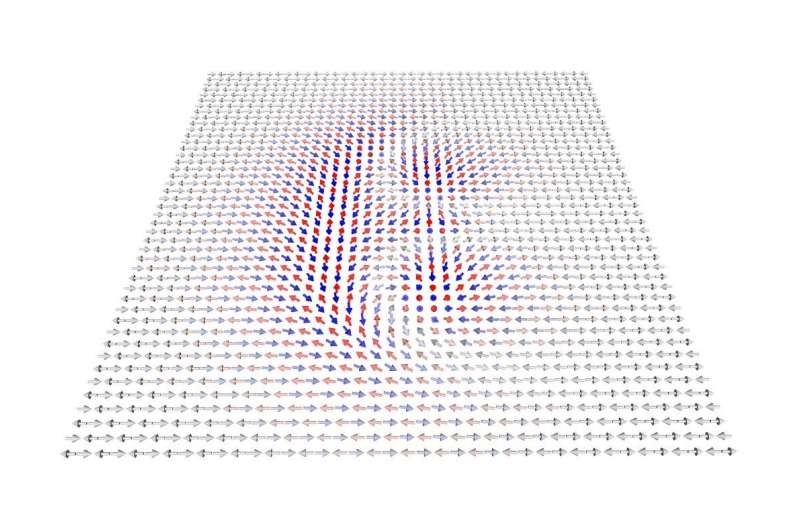The spin texture of an antiferromagnetic bimeron dimer. Credit: The Chinese University of Hong Kong, Shenzhen
Compared with the chiral spin textures in ferromagnets, their antiferromagnetic counterparts can be manipulated by spin currents with a more direct approach due to the absence of the skyrmion Hall effect, and much lower power consumption, as well. So far, most research has focused on isolated excitation in perpendicular antiferromagnetic spin systems, for example, skyrmion solitons. Meanwhile, the characteristics and the related physics of its in-plane analog, the bimeron, remain elusive.
Recently, an international research team from China, Japan, Australia, Poland, Slovakia and the United Kingdom theoretically investigated the current-excited dynamics of topologically nontrivial bimeron solitons and their clusters in an antiferromagnetic thin film with in-plane magnetic anisotropy.
They found that bimerons, similar to general antiferromagnetic quasi-particles, can be manipulated by spin currents. Their dynamics, however, show a strong dependence on the direction of the current polarization. Moreover, the bimeron solitons exhibit translational attractive interaction, which enables spontaneous formation of bimeron clusters with high Néel topological numbers. In addition, their counterparts with opposite Néel topological charge exist. This investigation suggests a rich class of particle-like spin textures allowed by the in-plane antiferromagnetic system, which can be manipulated by currents with high flexibility and efficiency.
"An antiferromagnetic bimeron is the in-plane analog of an antiferromagnetic skyrmion. They have several advantages over ferromagnetic spin textures, such as higher mobility and the absence of the skyrmion Hall effect. And the clustering behavior of the magnetic solitons will certainly make them more attractive," says Dr. Xiaoguang Li, a postdoctoral researcher at CUHKSZ, and one of the authors of this work. "The bimeron clusters can be efficiently manipulated by spin current, which makes them potential multi-bits data carriers. Moreover, their topological charge and size can be modified through the merging or annihilation with other clusters, which may provide a path towards magnetic topology-based computing."
More information: Xiaoguang Li et al. Bimeron clusters in chiral antiferromagnets, npj Computational Materials (2020). DOI: 10.1038/s41524-020-00435-y
Provided by The Chinese University of Hong Kong, Shenzhen
























